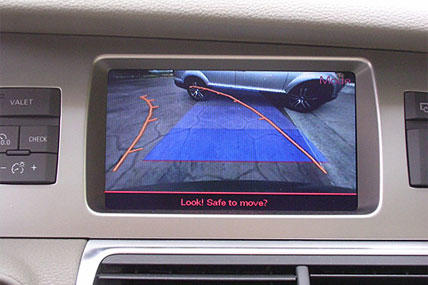Find out which high-tech features you should look for when shopping for a new vehicle.
It's a scary scenario that occurs daily on American highways: You take your eyes off the road to adjust the air conditioner or change the radio station, unaware of the traffic jam up ahead. By the time you look up, it's too late to stop. Or is it?
Imagine an autonomous system that sees obstacles in the road, predicts the impending crash and starts braking before you even realize you're in danger.
Thankfully, this high-tech safety feature — known as forward collision avoidance — is now a reality. It's one of many newer technologies available today as automakers computerize cars, apply radar innovation and expand the list of safety features that come standard on their vehicles.
Making Safety Standard
While newer technology typically appears on higher-end vehicles first, the trickle-down effect occurs over time as its benefits are proved, says Jesse Toprak, vice president of industry trends at TrueCar, an automotive solutions provider.
Take air bags, for instance. "They started with the most expensive cars, and now they're in every car," he says. Today's new cars have as many as 10 or more per vehicle, including side air bag curtains.
"I recommend consumers go with the maximum amount of safety features they can afford," says Toprak. "They could potentially save the lives of you and your family members."
Here's a rundown of the latest safety features to consider the next time you're shopping for the vehicle you can afford.
- Lane departure warning systems. These systems are designed to help prevent head-on collisions and other catastrophes. Cameras or other sensors, such as radar or infrared, are placed around the vehicle to determine its relative position in the lane. If you leave your lane, a light flashes and a high-pitched beep sounds. Some models have a vibrating steering wheel to alert you.
- Enhanced visibility. Some luxury vehicles offer infrared night vision that can alert you to obstacles that lurk beyond the reach of your headlights. Others employ adaptive headlights, which shift as you're turning, helping you see around curves.
- Rearview camera. A tiny camera mounted on the back of the vehicle transmits an image to your dashboard or rearview mirror, making it easier to see people or objects behind you. Once limited to luxury models, it's becoming a popular option on mid-range cars. Toprak says a pending regulation from the National Highway Traffic Safety Administration could make this technology standard on all vehicles by 2014.
- Reverse backup sensors. Operational with or without a camera, this equipment helps alert you if you're about to collide with something. "The closer you get to something as you reverse, the more frequent the beeps get," Toprak explains. "And this technology is not that costly. It's cheaper than the rearview camera."
- Automatic braking. Mentioned earlier, this system actually brakes the car to prevent a collision or lessen the impact from whatever is in front of you. Toprak predicts the system will be a standard safety feature in five to 10 years. "There's actually radar in front of the car, just like on a boat or plane, but a more simplified version," he explains.
- Forward collision avoidance system. Also called a pre-crash warning system, it's often combined with automatic braking. The system warns drivers, with visual or auditory clues, if they're about to run into something. Toprak says that various systems can pre-charge brakes, move the passenger seat back, position headrests to help you avoid whiplash, and apply partial or full brakes. The Insurance Institute for Highway Safety estimates that as many as 1.2 million crashes could be stopped or mitigated each year if all vehicles had this feature.
- Sideview assist. When a car is in your blind spot, sensors on the rear bumper can alert you with a light in your side mirror. Some systems warn you with a beep if you engage your turn signal.
- Parking assist. If you hate parallel parking, this one's for you. An increasing number of models offer a feature that detects the size of the parking space, guides you into the starting position, and then allows you to completely take your hands off the wheel while the computer backs the vehicle into place. As the technology becomes more widespread, it could help eliminate a lot of fender benders.
- Electronic stability control. Around for several years, this technology helps correct a swerving vehicle by applying brakes on individual wheels, giving drivers a chance to regain control. The Insurance Institute for Highway Safety says this technology reduces single vehicle fatal crashes by nearly 50%. Electronic stability control is a required standard feature on all models 2012 and later.
- Air bag systems. You might think they're old news, but air bag systems actually get more high-tech every year. Since late 2006, all passenger vehicles have been made with Advanced Frontal Airbag systems, which can automatically detect the size and position of the passenger and the severity of the crash and can use that information to vary the force with which the air bags inflate. Most newer cars also come with side-impact air bags (around the doors and windows), though only some cars offer them in the rear seats. Increasingly, automakers are offering innovative air bag technologies in different areas of the vehicle, such as Ford's inflatable seatbelts, and Scion's rear-window air bag.
Do they really work?
According to a 2012 Highway Loss Data Institute report, the new safety features aren¿t equally effective in preventing crashes.
- Proving their worth: Forward collision avoidance systems and adaptive headlights have been successful.
- Verdict still out: Analysis of lane departure warning systems has shown they haven't helped, and may have hurt, the frequency of collisions. Blind-spot detection and parking assist also aren't showing clear effects on crash patterns.
Extra Tip: How’s Your Recall?
Recalls help automakers alert buyers if there's a safety issue with a vehicle. To find out if a vehicle you drive is subject to a recall, sign up for the National Highway Traffic Safety Administration's recall notifications via email.










